Jungle Safari in Nepal - A Complete Information
Nepal's jungle safari experiences offer some of the world's most thrilling wildlife encounters, from spotting endangered Bengal tigers to observing one-horned rhinos in their natural habitat. At Luxury Holiday Nepal, we've crafted this comprehensive guide for adventure seekers, wildlife photographers, and luxury travelers who want to explore Nepal's incredible biodiversity while enjoying premium comfort and expert guidance.
Our years of experience organizing premium safari tours across Nepal's most pristine wilderness areas have taught us exactly what makes for an unforgettable jungle adventure. We'll walk you through the best national parks and wildlife reserves where you can witness rare species like snow leopards, red pandas, and Asian elephants up close.
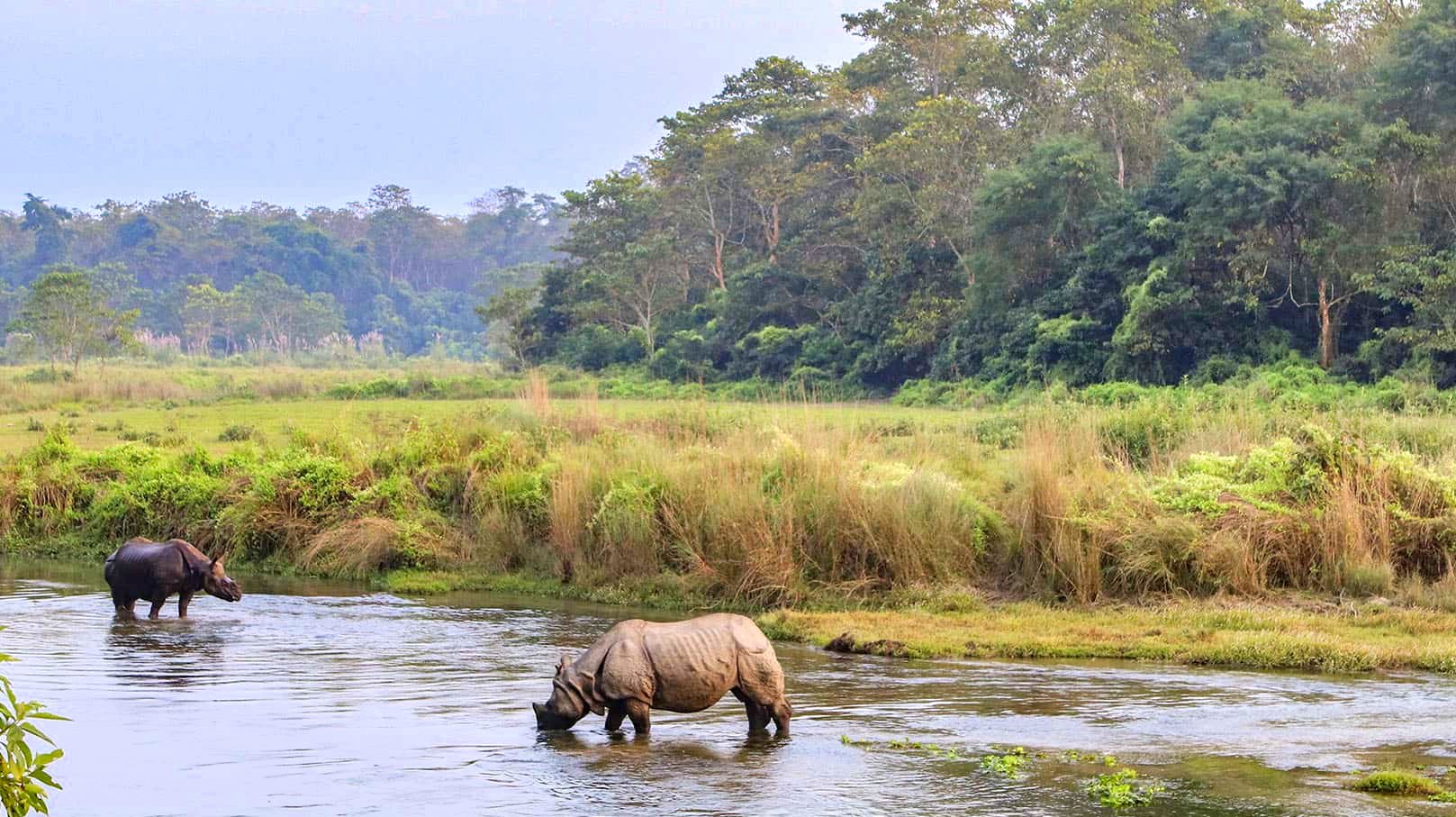
In this complete guide, we'll reveal the optimal times to visit for maximum wildlife sightings, ensuring your safari coincides with peak animal activity periods. We'll also showcase our handpicked luxury accommodation options that blend seamlessly with the natural environment while providing five-star amenities and personalized service.
From budget-friendly group expeditions to exclusive private safaris with dedicated naturalist guides, we'll help you choose the perfect safari package that matches your preferences and creates memories that last a lifetime.
Best National Parks and Wildlife Reserves for Jungle Safari
Chitwan National Park - Nepal's Premier Safari Destination
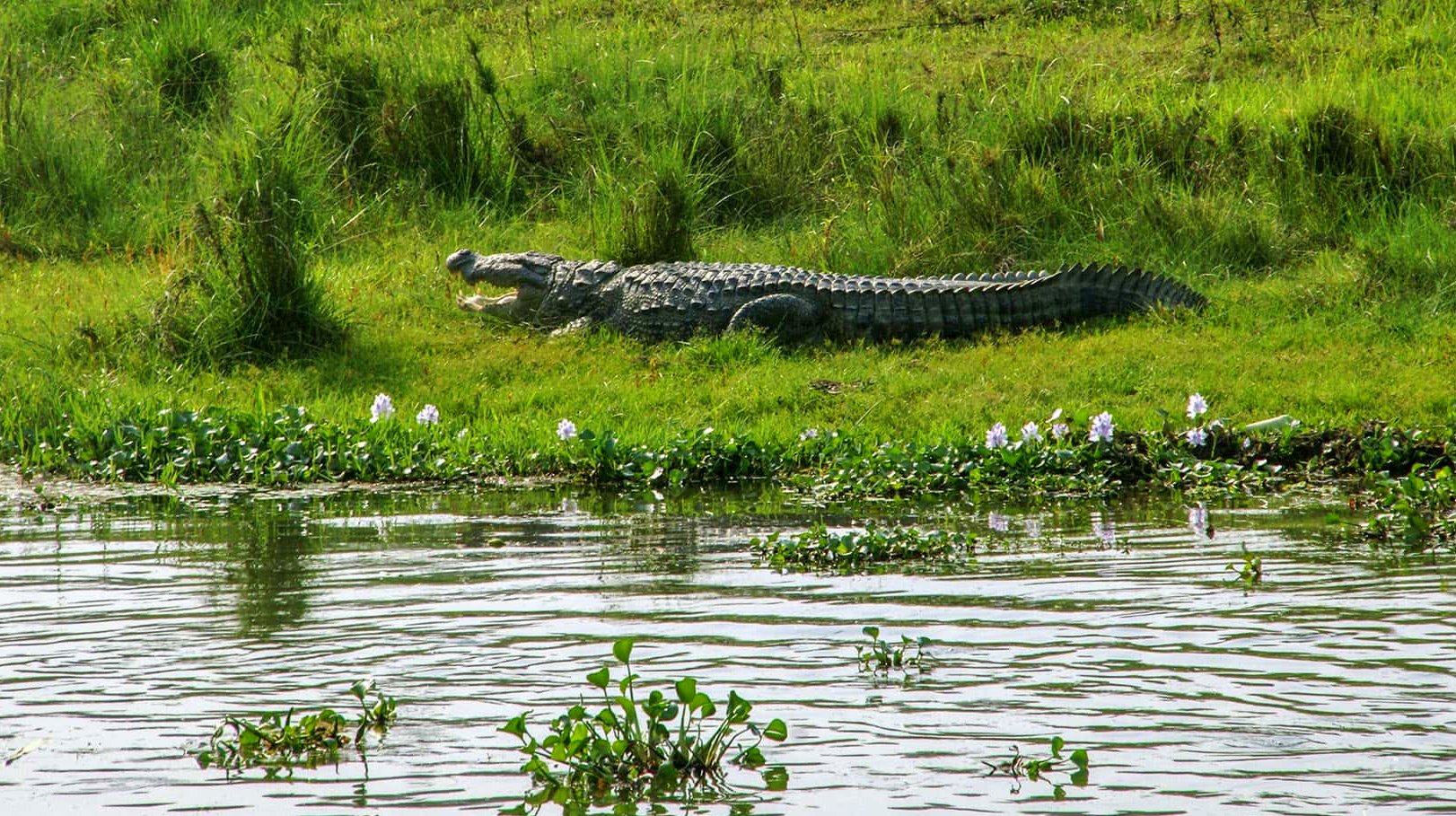
We consider Chitwan National Park the crown jewel of Nepal's safari destinations, and for good reason. Established in 1973 as Nepal's first national park, this UNESCO World Heritage Site spans 932 square kilometers of pristine subtropical lowlands in south-central Nepal. Our guests consistently tell us that Chitwan offers the perfect introduction to Nepal's wildlife scene.
The park's diverse ecosystem includes dense forests, grasslands, and riverine areas along the Rapti, Reu, and Narayani rivers. We've watched countless visitors get their first glimpse of the famous one-horned rhinoceros here, with the park housing over 600 of these magnificent creatures. The royal Bengal tiger population has grown significantly under protection, making Chitwan one of the best places in Nepal for tiger spotting.
What sets Chitwan apart is its accessibility and infrastructure. We can arrange everything from budget-friendly jungle lodges to luxury safari resorts within and around the park. The nearby town of Sauraha serves as the main gateway, offering numerous accommodation options and easy access to safari activities.
Our safari experiences here include jeep safaris, canoe trips along the Rapti River, and guided jungle walks. The park's well-maintained trails and experienced local guides ensure safe and memorable encounters with wildlife. We particularly recommend the early morning and late afternoon safaris when animals are most active.
Here are some of the suitable packages for Chitwan National Park :-
Bardia National Park - Remote Wilderness Experience
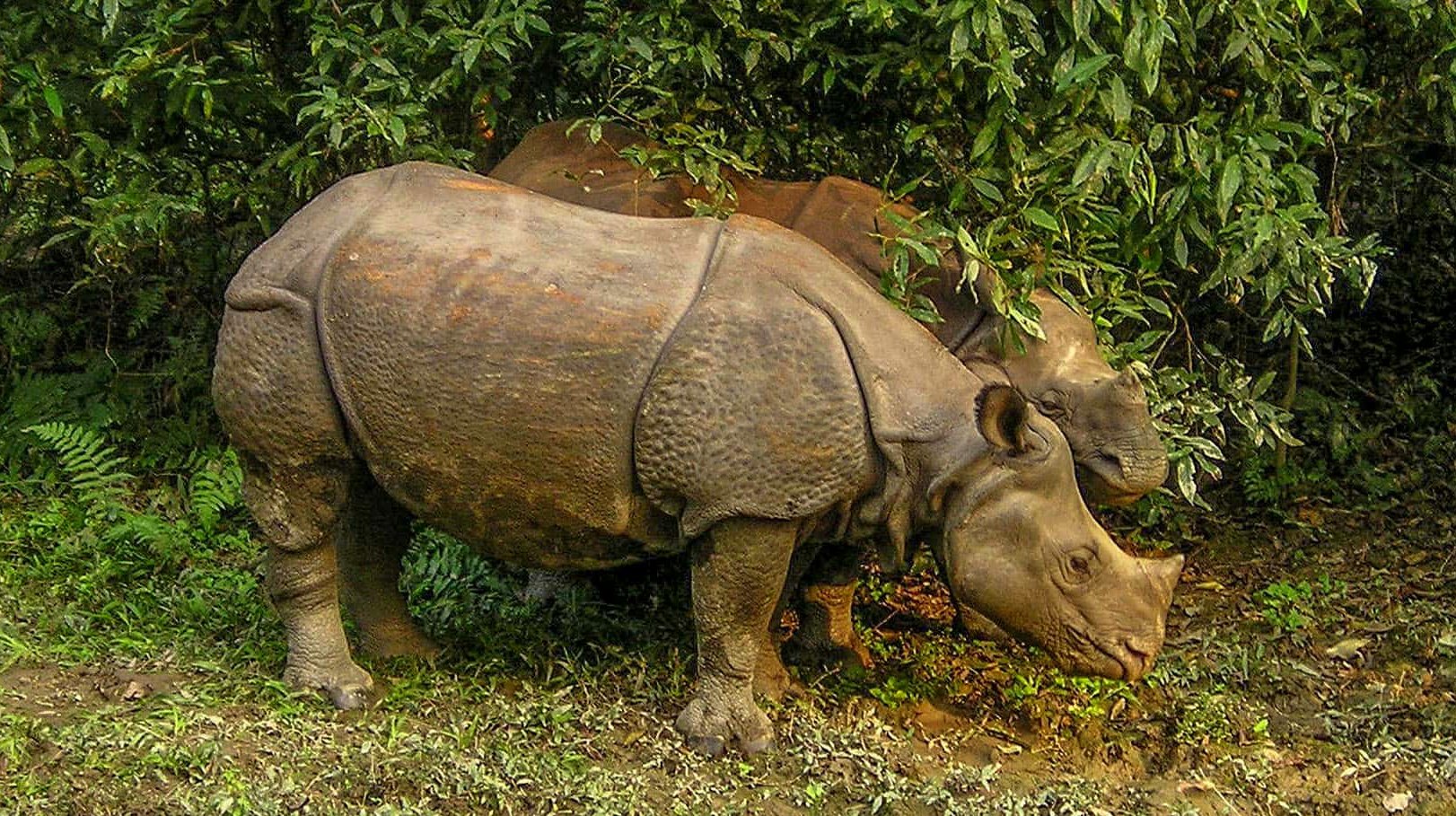
Bardia National Park offers what we call Nepal's most authentic wilderness experience. Located in the far western Terai, this 968-square-kilometer park remains refreshingly untouched by mass tourism. We often recommend Bardia to travelers seeking solitude and a more intimate connection with nature.
The park's remote location means we encounter fewer crowds but more wildlife. Bardia hosts Nepal's largest population of Bengal tigers, and our success rate for tiger sightings here surpasses most other destinations. The park also shelters the endangered one-horned rhinoceros, wild elephants, and over 400 bird species.
We love Bardia's diverse landscape, which includes sal forests, grasslands, and the pristine Karnali River system. The river creates perfect conditions for mugger crocodiles and Gangetic dolphins, species our guests rarely see elsewhere. During our river safaris, we frequently spot these elusive creatures alongside numerous waterfowl.
The authentic Tharu culture surrounding Bardia adds another dimension to our safari packages. We arrange visits to traditional Tharu villages where guests experience local customs, cuisine, and traditional stick dances. The community-based conservation programs here demonstrate how local people and wildlife can coexist successfully.
Our Bardia safaris typically include jeep drives, nature walks, river rafting, and cultural experiences. The park's excellent network of dirt roads allows us to explore remote areas where wildlife sightings are almost guaranteed.
Here are some of the suitable packages for Bardia National Park :-
Banke National Park - Hidden Gem for Wildlife Enthusiasts
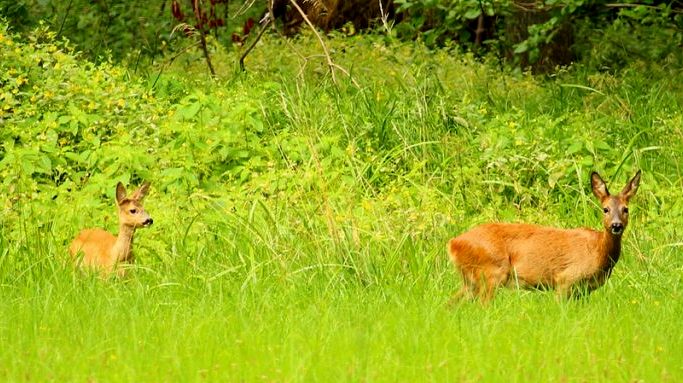
Banke National Park represents our best-kept secret for serious wildlife enthusiasts. Established in 2010, this 550-square-kilometer park in the mid-western Terai connects with Bardia National Park, creating a massive protected corridor for wildlife movement.
We appreciate Banke's pristine condition and minimal human interference. The park's location along the Rapti River creates diverse habitats supporting an impressive array of species. Our wildlife monitoring data shows healthy populations of tigers, leopards, elephants, and sloth bears thriving in these protected forests.
The park's unique feature is its successful community forestry programs. We work closely with local Tharu communities who serve as excellent guides and share their traditional knowledge about wildlife behavior and forest ecology. Their insights often lead to extraordinary wildlife encounters that guidebooks can't provide.
Our Banke safari packages focus on walking safaris and bird watching tours. The park's extensive trail network takes us through dense sal forests, grasslands, and riverine areas. We've recorded over 300 bird species here, making it a paradise for ornithologists and casual bird watchers alike.
What makes Banke special is its tranquility. We often spend entire days without meeting other tourists, allowing for uninterrupted wildlife observation and photography. The park's accommodation options are limited but comfortable, with community-run lodges providing authentic local experiences.
Shuklaphanta National Park - Grassland Safari Adventure
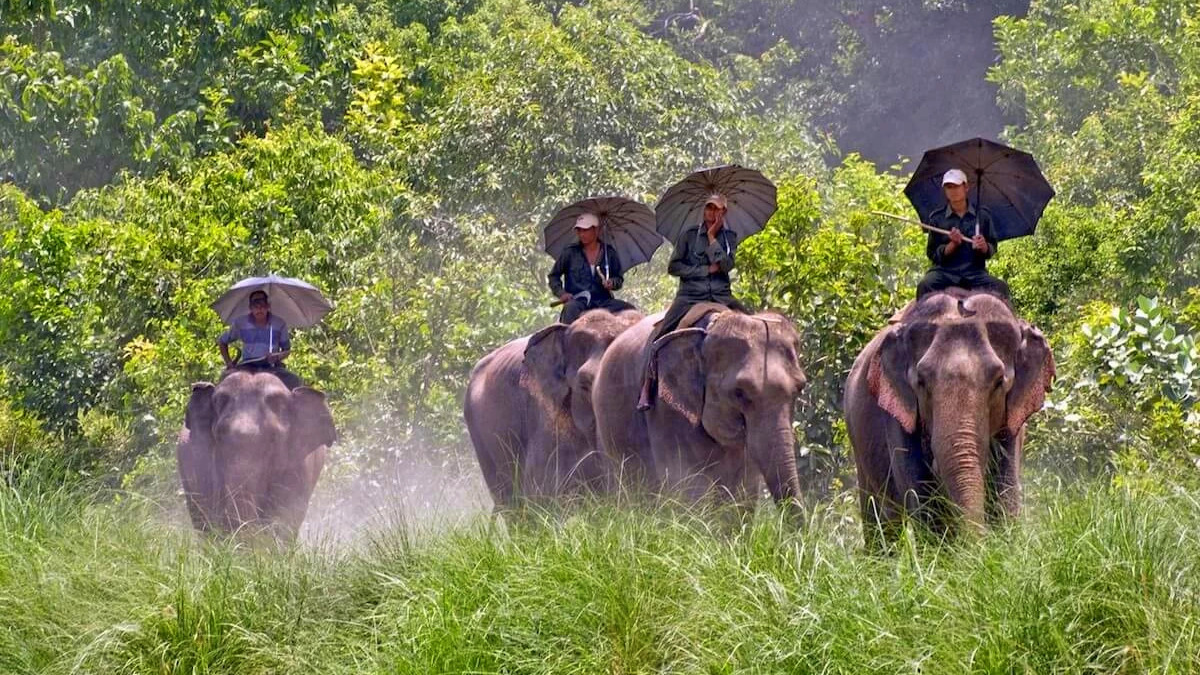
Shuklaphanta National Park offers our most unique grassland safari experience in Nepal's far-western corner. Covering 305 square kilometers, this park protects the largest remaining area of grassland in the Terai, creating a landscape unlike anywhere else in Nepal.
We're constantly amazed by the park's swamp deer population - the largest herd in the world with over 2,000 individuals. These magnificent creatures create spectacular scenes as they graze across the expansive grasslands. The park also supports healthy populations of tigers, elephants, and the endangered hispid hare.
The park's flat terrain and open grasslands provide excellent opportunities for wildlife photography and observation. We can spot animals from considerable distances, and the lack of dense forest cover means better visibility for our guests. The park's numerous waterholes and small lakes attract diverse wildlife, especially during dry seasons.
Our Shuklaphanta safaris emphasize jeep drives across the grasslands and visits to the various lakes and wetlands. The Rani Tal lake system supports numerous waterfowl and provides excellent bird watching opportunities. We also arrange nature walks along designated trails and visits to the nearby Tharu communities.
The park's remote location means fewer visitors but requires more planning. We handle all logistics, including transportation from nearby towns and accommodation in local lodges. The journey to Shuklaphanta becomes part of the adventure, taking us through rural Nepal and offering glimpses of traditional life along the way.
Wildlife Species You Can Encounter During Safari
Royal Bengal Tigers - Spotting Nepal's Apex Predator
We can't think of a more thrilling wildlife encounter than spotting a Royal Bengal Tiger in its natural habitat. Nepal's Chitwan and Bardia National Parks offer some of the world's best opportunities to see these magnificent cats. Our safaris have shown us that these powerful predators prefer dense grasslands, riverine forests, and sal woodlands where they can hunt their preferred prey like spotted deer, wild boar, and even young rhinos.
We've learned that patience is key when tracking tigers. Early morning and late afternoon game drives give us the highest chances of sightings when tigers are most active. During our guided safaris, we often spot pug marks in muddy riverbanks or catch glimpses of orange and black stripes moving through tall elephant grass. The resident tigers in Chitwan have become somewhat accustomed to safari vehicles, allowing us incredible photo opportunities when luck strikes.
Our expert guides know individual tigers by their unique stripe patterns and can share fascinating stories about territorial behaviors, hunting techniques, and family dynamics. We've witnessed mothers teaching cubs essential survival skills and observed the impressive strength of adult males marking their territory. These encounters remind us why Nepal's tiger conservation efforts are so crucial - we're protecting not just an iconic species, but an entire ecosystem.
One-Horned Rhinoceros - Rare Giants of the Grasslands
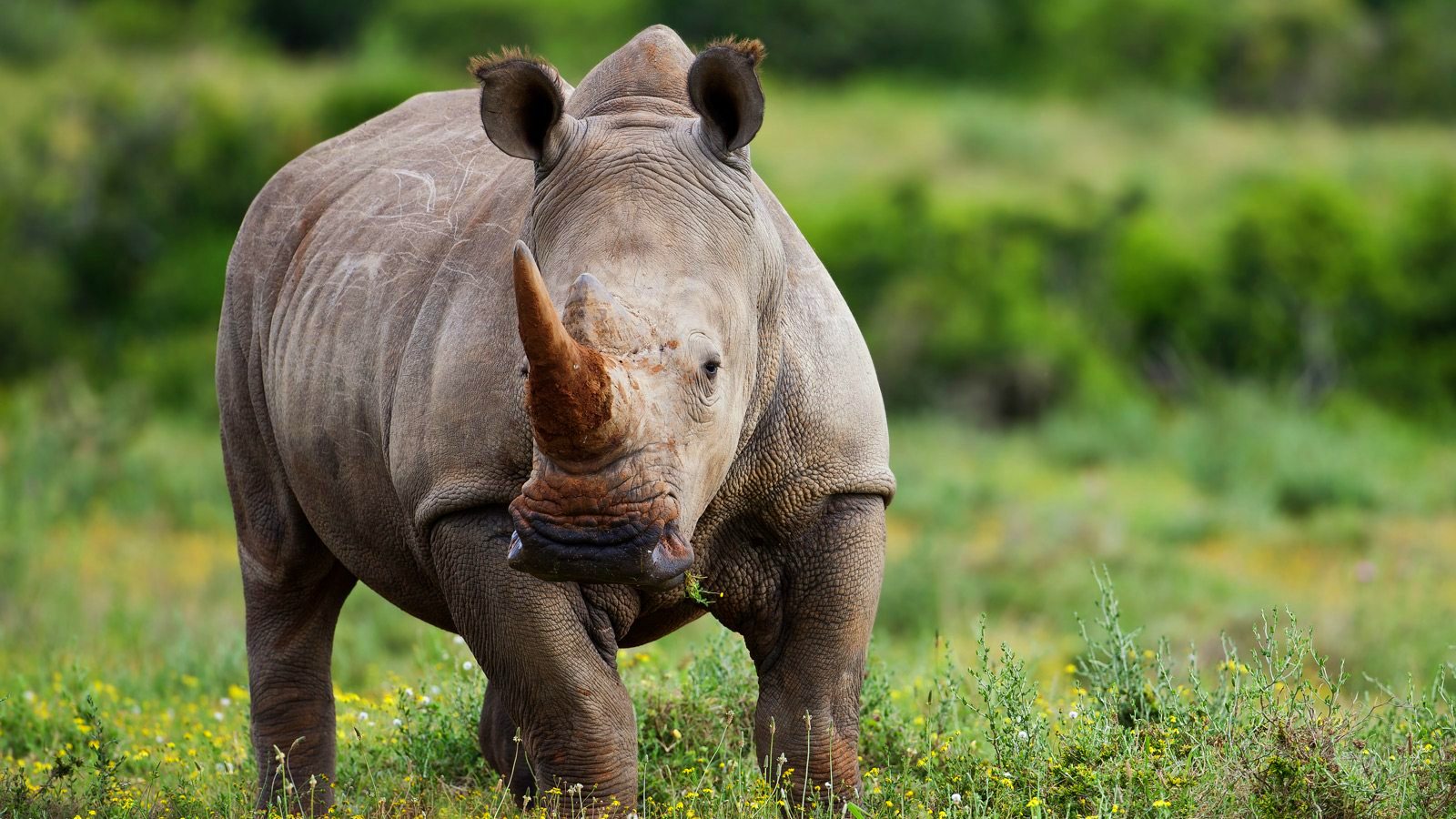
We consider the Greater One-Horned Rhinoceros one of Nepal's greatest conservation success stories. These prehistoric-looking giants, found primarily in Chitwan and Bardia National Parks, represent one of the world's most significant wildlife recovery programs. We've watched their population grow from fewer than 100 individuals to over 650 today through dedicated conservation efforts.
During our rhino tracking expeditions, we're always amazed by their impressive size - adults can weigh up to 2,200 kg and stand nearly 6 feet tall. We observe them grazing peacefully in grasslands, wallowing in mud pools to cool themselves, and displaying surprising agility despite their bulky appearance. Their single horn, made of compressed hair rather than bone, makes them instantly recognizable among Asian rhino species.
We've discovered that rhinos are most active during cooler parts of the day, making dawn and dusk safaris particularly rewarding. Our guides help us maintain safe distances while explaining rhino behavior, including their excellent hearing and sense of smell that compensate for poor eyesight. We often encounter mothers with calves, creating heartwarming family scenes against Nepal's stunning grassland backdrop. These gentle giants prefer areas near water sources where they can drink regularly and enjoy mud baths that protect their skin from insects and sun.
Asian Elephants - Gentle Giants in Their Natural Habitat
We find Asian Elephants among Nepal's most intelligent and emotionally complex wildlife species. During our safaris in Chitwan, Bardia, and Koshi Tappu, we observe wild elephant herds displaying intricate social structures led by experienced matriarchs. These magnificent creatures, smaller than their African cousins but equally impressive, roam freely through dense forests and open grasslands.
Our wildlife experiences reveal fascinating elephant behaviors - we watch family groups communicating through low-frequency rumbles, see young calves learning essential survival skills from their mothers, and observe the protective instincts that keep herds safe from predators. We've been privileged to witness tender moments like elephants caring for injured family members or celebrating births within the herd.
We recommend keeping respectful distances during elephant encounters, as these powerful animals can be unpredictable, especially when protecting young. Our expert guides help us identify different herd dynamics and explain seasonal migration patterns that bring elephants through various park regions. We often spot elephants near water sources during dry seasons, creating perfect opportunities for photography and observation. The experience of watching wild elephants in their natural environment, free from human interference, connects us deeply with Nepal's incredible biodiversity and conservation efforts.
Exotic Bird Species - Paradise for Birdwatchers
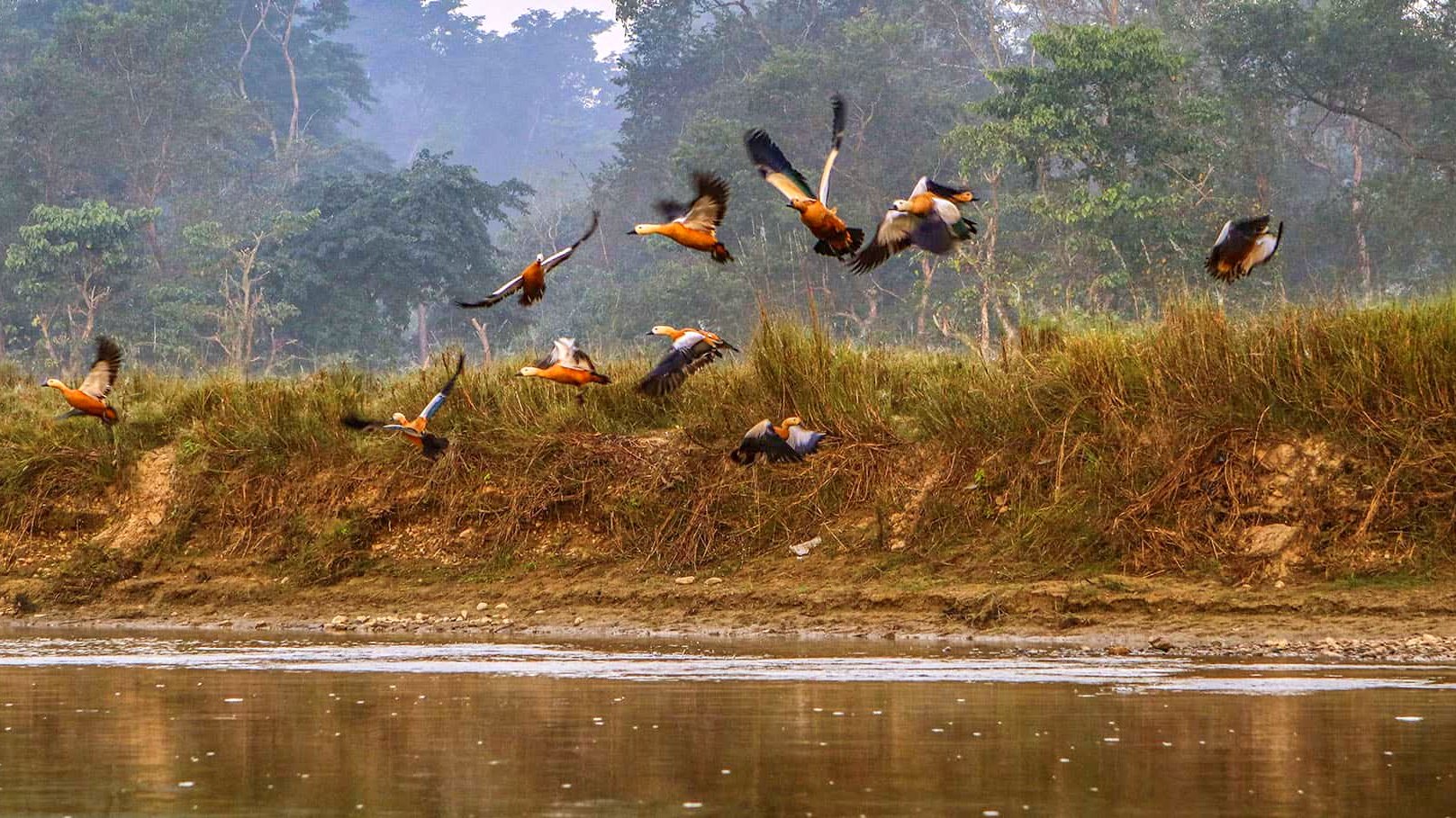
We've recorded over 900 bird species across Nepal's diverse ecosystems, making jungle safaris a dream destination for birdwatching enthusiasts. Our birding expeditions reveal an incredible variety from tiny sunbirds to massive hornbills, each perfectly adapted to their specific habitat zones. During early morning safaris, we experience the magical dawn chorus when hundreds of species fill the air with melodious calls.
We encounter spectacular birds like the Great Hornbill with its impressive casque, colorful Bee-eaters catching insects mid-flight, and various species of Kingfishers diving for fish in pristine rivers. Our guides help us spot elusive species like the Bengal Florican, one of the world's rarest birds found in Chitwan's grasslands, and various eagles soaring overhead searching for prey.
Wetland areas provide us with incredible waterfowl diversity including painted storks, various herons, and migrating ducks during winter months. We've photographed vibrant barbets, woodpeckers, and parakeets in forest canopies, while ground-dwelling species like junglefowl and peafowl create stunning displays during mating seasons. Our bird photography workshops help capture these magnificent creatures in their natural behaviors, from feeding and nesting to elaborate courtship rituals that showcase nature's incredible artistry.
Leopards, Bears and Other Carnivores
We track several elusive carnivore species that make Nepal's jungles complete predator ecosystems. Leopards represent one of our most challenging yet rewarding sightings - these spotted cats are masters of camouflage and primarily nocturnal, requiring special night safari experiences or incredible luck during day excursions. We've spotted them resting in tree branches or catching glimpses of rosette patterns disappearing into dense undergrowth.
Our encounters with Asiatic Black Bears happen most frequently in higher elevation forests where they forage for fruits, honey, and insects. These powerful omnivores show remarkable climbing abilities and intelligence when searching for food sources. We maintain extra caution during bear territory exploration since mothers with cubs can be particularly protective.
We also track various smaller carnivores that play crucial ecological roles. Wild dogs, also known as dholes, hunt in coordinated packs and represent one of Asia's most endangered canids. Our safaris reveal jungle cats stalking through grasslands, various mongoose species controlling rodent populations, and martens navigating forest canopies with incredible agility. Hyenas, though rare, occasionally appear during night drives, completing the carnivore diversity that maintains natural balance within Nepal's protected ecosystems. Each predator species contributes to the complex food web that makes these wilderness areas so fascinating for wildlife enthusiasts.
Types of Safari Activities Available
Jeep Safari - Comfortable Wildlife Exploration
We recommend jeep safari as the most popular and versatile way to explore Nepal's wilderness areas. Our specially modified 4WD vehicles can navigate through dense jungle trails, grasslands, and river beds while keeping you safe and comfortable. During our jeep safaris, we typically spend 3-4 hours exploring different zones of the national parks, maximizing your chances of spotting tigers, rhinos, elephants, and various bird species.
Our experienced drivers and naturalist guides know exactly where animals tend to gather during different times of the day. We often start early morning safaris around 6 AM when nimals are most active, or schedule afternoon drives around 3 PM to catch the evening wildlife movements. The elevated position in our jeeps gives you excellent photography opportunities and panoramic views of the landscape.
We equip all our safari vehicles with comfortable seating, sun protection, and emergency communication devices. Our jeeps can accommodate up to 6 passengers, making them perfect for families or small groups who want to share the excitement together.
Canoe Safari - River Wildlife Watching
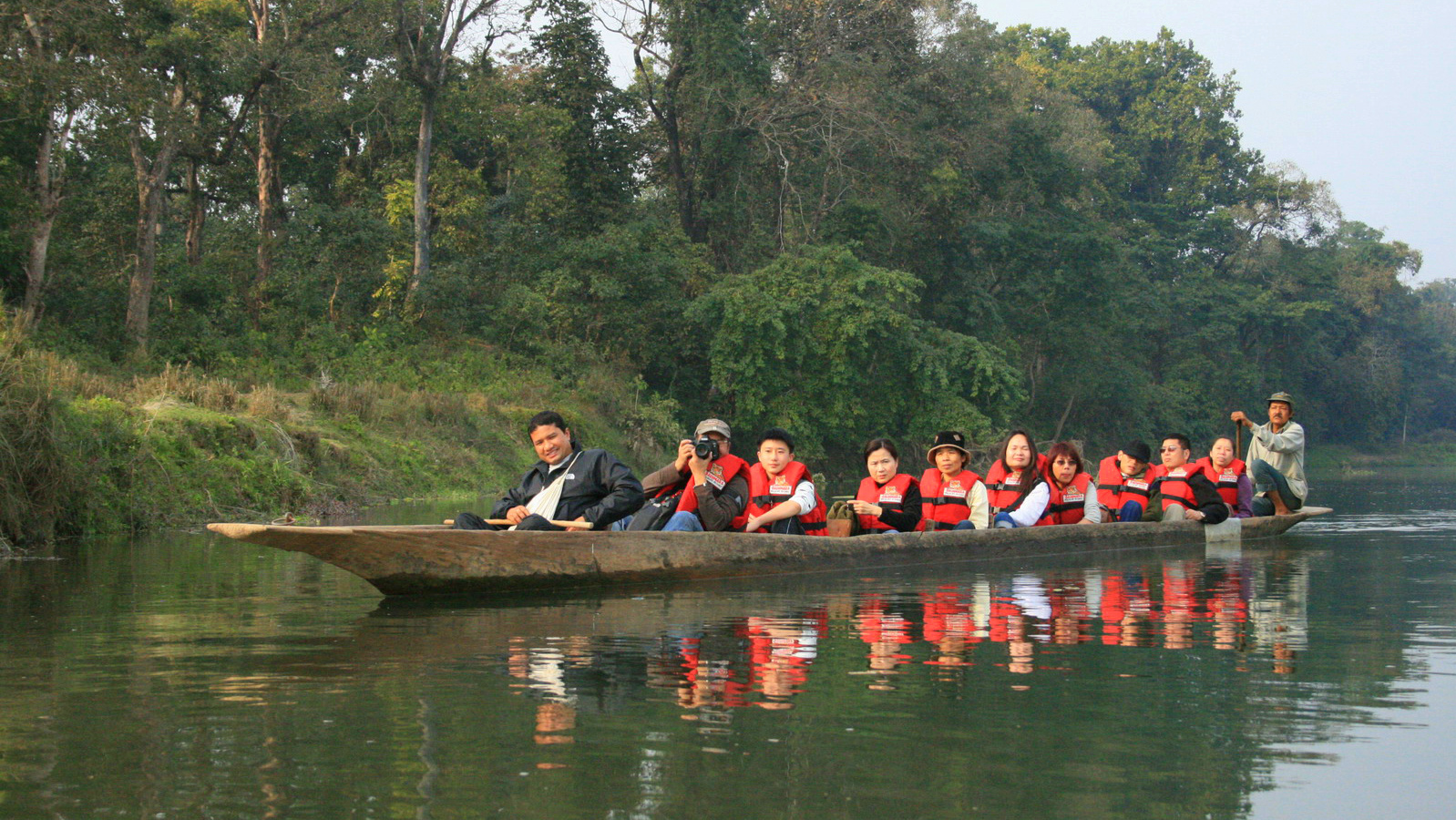
We organize peaceful canoe safaris along Nepal's pristine jungle rivers, offering a completely different safari experience. Gliding silently through calm waters, we can observe riverside wildlife without disturbing their natural behavior. Our traditional dugout canoes, skillfully navigated by local boatmen, allow us to get remarkably close to crocodiles, water birds, and animals coming to drink at the riverbank.
During our canoe journeys, we frequently spot gharial and marsh mugger crocodiles basking on sandy beaches, various species of kingfishers, herons, and storks fishing in shallow waters. We've also encountered elephants bathing, deer drinking, and even tigers cooling off during hot afternoons.
Our canoe safaris work best during dry seasons when water levels are manageable and wildlife concentrates around permanent water sources. We provide life jackets for safety and our guides carry waterproof bags for your cameras and belongings. These peaceful river journeys typically last 2-3 hours and offer excellent opportunities for photography and birdwatching.
Walking Safari - Close Encounter with Nature
We believe walking safaris provide the most intimate connection with Nepal's jungle environment. On foot, we can explore areas inaccessible to vehicles, following animal tracks, examining plants, and truly experiencing the sights, sounds, and smells of the wilderness. Our armed guards and expert naturalist guides ensure your safety while sharing fascinating insights about jungle ecology, animal behavior, and survival techniques.
During our walking safaris, we often discover fresh tiger pug marks, rhino wallows, and elephant feeding areas. We can examine medicinal plants traditionally used by local communities, identify different tree species, and spot smaller wildlife like various lizards, butterflies, and insects that you'd miss from a vehicle.
Our walking routes vary from easy nature walks lasting 1-2 hours to more challenging jungle treks covering 4-5 hours. We adjust the difficulty level based on your fitness level and interests. We always carry first aid supplies, plenty of water, and maintain radio contact with our base camps for added security.
Best Time to Visit for Optimal Wildlife Viewing
Dry Season Advantages - October to March
We consistently recommend the dry season as the prime time for jungle safaris in Nepal, and there's good reason for this. During these months, we see dramatically reduced rainfall, which means clearer trails, better visibility, and more comfortable walking conditions for our safari adventures.
The vegetation becomes thinner as the dry months progress, making wildlife spotting significantly easier. We've observed that animals tend to gather around water sources during this period, creating excellent opportunities for concentrated wildlife viewing. Our guests regularly spot rhinos, tigers, and various deer species at these predictable watering holes.
Temperature-wise, we find October through March offers the most pleasant experience. Morning and evening temperatures are comfortable for extended outdoor activities, while midday heat remains manageable. We particularly love the crisp morning air during this season - perfect for those early dawn safaris when animals are most active.
Peak months breakdown:
-
October-November: Excellent visibility, comfortable temperatures
-
December-February: Cool mornings, warm afternoons, minimal rainfall
-
March: Increasingly warm but still optimal for wildlife viewing
Monsoon Season Considerations - June to September
We need to be honest about monsoon season challenges, though it's not entirely off-limits for safaris. Heavy rainfall creates muddy trails, reduces visibility due to lush vegetation, and makes some areas completely inaccessible. Many of our regular safari routes become impassable during peak monsoon months.
However, we've discovered some unexpected advantages during this period. The landscape transforms into a vibrant green paradise, creating stunning photographic opportunities. Bird watching reaches its peak as migratory species arrive, and we often see increased activity among certain wildlife species.
Monsoon season realities:
-
Road conditions: Many jungle roads become difficult or impossible to navigate
-
Accommodation limitations: Some wilderness lodges close during heavy monsoon periods
-
Wildlife behavior: Animals often seek dense forest cover, making spotting more challenging
-
Photography: Overcast skies and frequent rain affect photo quality
We typically advise our clients to avoid July and August unless they're specifically interested in monsoon forest ecosystems or bird migration patterns.
Wildlife Behavior Patterns Throughout the Year
Understanding animal behavior throughout the seasons helps us plan more successful safari experiences. We've spent years observing these patterns and can share some fascinating insights.
During dry months, we notice animals becoming more predictable in their movements. Water scarcity drives them to established water sources, making our job of locating them much easier. Tigers, for instance, often patrol specific territories around rivers and lakes during this time.
Seasonal wildlife patterns:
|
Season |
Tiger Behavior |
Rhino Activity |
Bird Life |
Elephant Movement |
|
Dry Season |
More visible, frequent water visits |
Active during cooler hours |
Resident species dominant |
Concentrated around water |
|
Monsoon |
Dense cover dwelling |
Less visible, muddy wallowing |
Peak migration activity |
Scattered, harder to track |
We've observed that breeding seasons also influence wildlife visibility. Many species become more active during specific months - deer rutting season in autumn creates excellent viewing opportunities, while bird nesting season during the monsoon brings unique behavioral displays.
Leopards show different patterns entirely, becoming more nocturnal during warmer months and occasionally more visible during cooler dry season days. We've learned to adjust our safari timing based on these natural rhythms.
The key insight we share with our clients is that each season offers unique experiences. While dry season provides classic safari advantages, we encourage wildlife enthusiasts to consider what specific experiences they're seeking - whether it's guaranteed animal sightings or witnessing natural seasonal transformations.
Luxury Safari Accommodation Options
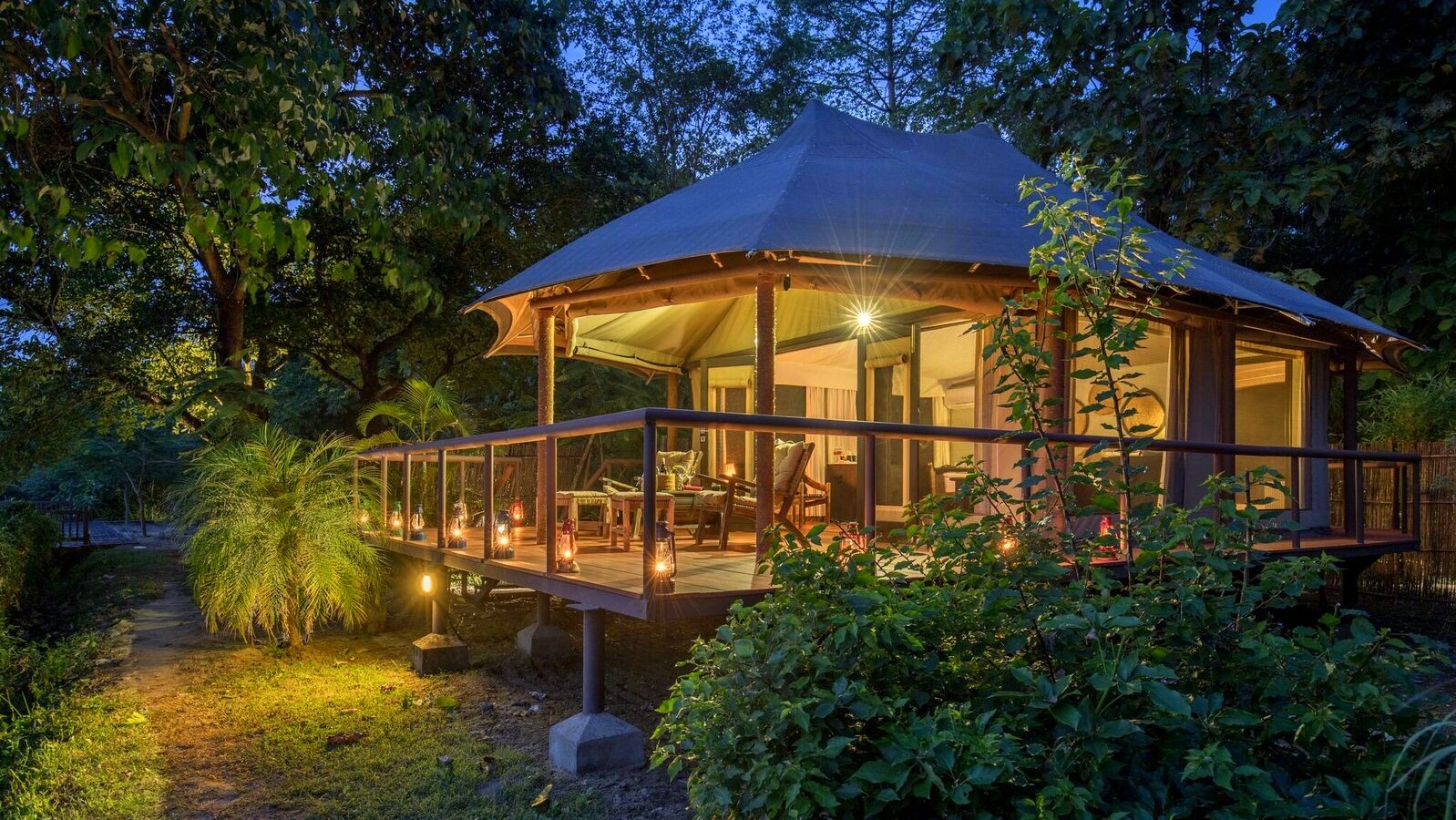
High-End Jungle Resorts and Lodges
We've carefully selected the most prestigious jungle accommodations that redefine safari luxury in Nepal. These world-class resorts blend seamlessly with their natural surroundings while offering five-star amenities that exceed international standards.
Our premium lodge partners in Chitwan National Park feature spacious suites with private terraces overlooking pristine wilderness, complete with marble bathrooms and climate-controlled comfort. We ensure each property maintains the highest service standards, with dedicated naturalist guides, private vehicles, and personalized safari schedules tailored to your preferences.
In Bardia National Park, our exclusive partner lodges offer elevated tree-house style accommodations with panoramic forest views. These architectural marvels incorporate sustainable design principles while providing modern luxuries like infinity pools, spa services, and gourmet dining experiences featuring local and international cuisine.
We work exclusively with lodges that prioritize wildlife conservation and community engagement. Our selected properties contribute directly to park protection efforts and employ local communities, ensuring your luxury experience supports meaningful conservation initiatives.
Each high-end lodge in our portfolio offers unique experiences - from private elephant encounters to guided botanical walks with renowned naturalists. We guarantee spacious accommodations with king-sized beds, premium linens, and 24-hour room service, creating the perfect sanctuary after adventurous safari days.
Luxury Tented Camps Experience
We offer extraordinary tented camp experiences that combine authentic safari adventure with uncompromising luxury. Our carefully curated tented accommodations provide an immersive wilderness experience without sacrificing comfort or elegance.
These aren't ordinary camping experiences - we partner with operators who provide spacious canvas pavilions featuring hardwood floors, elegant furnishings, and full bathrooms with hot water. Each tent includes comfortable beds with premium mattresses, quality linens, and climate control systems that ensure perfect comfort regardless of seasonal variations.
Our tented camps are strategically positioned in prime wildlife viewing locations, often in exclusive concession areas that offer enhanced game viewing opportunities away from crowded tourist zones. We ensure each camp maintains minimal environmental impact while maximizing your connection to Nepal's incredible biodiversity.
|
Tented Camp Features |
Standard Inclusions |
|
Canvas Pavilion Size |
400+ sq ft per tent |
|
Bathroom Facilities |
Private ensuite with hot water |
|
Dining Options |
Multi-course gourmet meals |
|
Wildlife Activities |
Guided walks, jeep safaris |
|
Staff Ratio |
3:1 staff to guest ratio |
We provide dedicated camp managers who coordinate all activities, from sunrise game drives to evening cultural performances. Our tented camps offer communal dining experiences where guests share safari stories around carefully designed fire pits, creating lasting memories and friendships.
Boutique Wildlife Hotels
We've partnered with distinctive boutique properties that offer intimate wildlife experiences with personalized service and unique character. These smaller-scale accommodations provide exceptional attention to detail and customized safari programs that larger resorts simply cannot match.
Our boutique hotel selections feature individually designed rooms and suites, each reflecting local cultural elements while maintaining contemporary luxury standards. We ensure these properties offer exceptional locations - many overlook active wildlife corridors or provide direct access to lesser-known park areas where wildlife sightings are more exclusive and authentic.
These intimate properties typically accommodate fewer than 20 guests at any time, allowing our teams to provide highly personalized service. We work with boutique hotels that offer specialized experiences like photography workshops with professional wildlife photographers, traditional cooking classes using locally sourced ingredients, and private yoga sessions in pristine natural settings.
Our boutique partners often feature unique architectural designs inspired by traditional Nepali craftsmanship, incorporating local materials like bamboo, stone, and reclaimed wood. We ensure each property maintains sustainable practices, from solar power systems to organic gardens that supply fresh ingredients for exceptional dining experiences.
We guarantee that our boutique wildlife hotels provide exclusive access to expert naturalists who offer in-depth knowledge about local ecosystems, bird species identification, and conservation challenges. These properties often include private libraries, observation decks, and specialized equipment like high-quality binoculars and field guides to enhance your wildlife appreciation experience.
Essential Safari Preparation and Packing Tips
Clothing and Gear Requirements
We recommend packing lightweight, breathable clothing in neutral colors like khaki, olive green, and brown to blend with the natural environment. Cotton and moisture-wicking synthetic fabrics work best in Nepal's humid jungle climate. Long-sleeved shirts and pants are essential for protection against mosquitoes, leeches, and thorny vegetation.
Our packing checklist includes:
Essential Clothing:
-
Lightweight trekking pants (2-3 pairs)
-
Long-sleeved shirts with UV protection
-
Moisture-wicking t-shirts
-
Warm fleece jacket for early morning safaris
-
Rain jacket and waterproof pants
-
Comfortable hiking boots with ankle support
-
Thick socks to prevent leeches
-
Wide-brimmed hat with chin strap
-
Lightweight scarf or bandana
Gear Essentials:
-
High-quality binoculars (8x42 recommended)
-
Flashlight or headlamp with extra batteries
-
Insect repellent (DEET-based)
-
Sunscreen (SPF 30+)
-
Water bottles or hydration pack
-
Small backpack for day trips
-
Waterproof bags for electronics
We suggest avoiding bright colors, white clothing, and noisy materials that might disturb wildlife. Pack layers since temperatures can vary significantly between dawn game drives and midday heat.
Photography Equipment for Wildlife Shots
We know capturing Nepal's incredible wildlife requires specific equipment and techniques. A telephoto lens is absolutely crucial - we recommend at least 300mm, though 400-600mm lenses produce the best results for distant animals.
Camera Equipment Priorities:
|
Equipment |
Recommended Specs |
Purpose |
|
Camera Body |
DSLR/Mirrorless with good ISO performance |
Low light performance |
|
Telephoto Lens |
300-600mm with image stabilization |
Wildlife photography |
|
Wide-angle Lens |
16-35mm |
Landscape shots |
|
Memory Cards |
High-speed, large capacity |
Continuous shooting |
|
Extra Batteries |
Camera-specific |
Extended shooting sessions |
Additional Photography Gear:
-
Lens cleaning kit for dusty conditions
-
Waterproof camera cover
-
Tripod or monopod for stability
-
External flash for close-up shots
-
Protective camera bag or case
We always pack extra memory cards since wildlife photography involves taking hundreds of shots to capture that perfect moment. Fast autofocus is critical when photographing moving animals, so ensure your camera settings are optimized before heading out.
Health and Safety Precautions
We prioritize your health and safety throughout your jungle safari experience. Nepal's tropical regions present unique health challenges that require proper preparation and awareness.
Medical Preparations:
-
Consult your doctor 4-6 weeks before travel
-
Update routine vaccinations (tetanus, hepatitis A&B)
-
Consider Japanese encephalitis vaccination
-
Pack a comprehensive first aid kit
-
Bring personal medications with prescriptions
-
Include anti-diarrheal medication
-
Carry oral rehydration salts
Safety Measures We Implement:
-
Experienced naturalist guides accompany all activities
-
Safety briefings before each safari activity
-
Emergency communication equipment
-
Trained staff in first aid procedures
-
Clear safety protocols for wildlife encounters
Common Health Risks and Prevention:
-
Malaria: Use prophylaxis if recommended and sleep under nets
-
Dengue fever: Prevent mosquito bites with repellent and long sleeves
-
Traveler's diarrhea: Drink bottled water and eat at reputable establishments
-
Heat exhaustion: Stay hydrated and take regular breaks
-
Cuts and infections: Keep wounds clean and covered
We maintain close contact with local medical facilities and can arrange emergency evacuations if necessary. Our guides carry satellite phones in remote areas for immediate communication.
Documentation and Permits Needed
We handle most permit arrangements for our guests, but you'll need to provide specific documentation and meet certain requirements for your jungle safari adventure.
Required Travel Documents:
-
Valid passport (minimum 6 months remaining)
-
Nepal tourist visa (available on arrival or online)
-
Travel insurance with medical coverage
-
Yellow fever certificate (if traveling from affected areas)
-
Emergency contact information
Safari-Specific Permits:
-
National park entry permits (we arrange these)
-
TIMS card for trekking components
-
Photography permits for professional equipment
-
Special permits for restricted areas
Documentation Process:
We streamline the permit process by collecting your information in advance and coordinating with local authorities. Most national park permits can be obtained the same day, but we recommend advance booking during peak seasons to guarantee entry.
What We Need from You:
-
Passport copy (clear, full page)
-
Recent passport-sized photos (2-3 copies)
-
Completed health questionnaire
-
Emergency contact details
-
Travel insurance policy information
Important Notes:
Some areas require special conservation fees or community permits that vary by season and group size. We provide detailed information about all costs upfront so there are no surprises. Keep all original documents secure and carry copies during safari activities.
Complete Safari Itinerary Options
3-Day Quick Safari Package
Our 3-day safari package offers the perfect introduction to Nepal's incredible wildlife without requiring extensive time off. We've designed this itinerary specifically for travelers who want maximum wildlife exposure in a short timeframe.
Day 1: We pick you up from your hotel and transfer you directly to Chitwan National Park, Nepal's premier wildlife destination. After checking into your accommodation, we start with an evening jungle walk where you'll get your first glimpse of the park's diverse ecosystem. Our experienced guides introduce you to bird watching techniques and help you spot some of the 500+ bird species that call Chitwan home.
Day 2: The adventure kicks into high gear with an early morning elephant safari through the dense grasslands and forests. We've found that dawn hours offer the best chances of spotting rhinos, deer, and if you're lucky, the elusive Bengal tiger. After breakfast, we take you on a thrilling jeep safari to explore different zones of the park. The afternoon includes a visit to the elephant breeding center and a cultural program featuring traditional Tharu dances.
Day 3: We start with a peaceful canoe ride along the Rapti River, where you'll see crocodiles basking in the sun and various water birds. Before departure, we arrange one final jungle walk to capture any wildlife you might have missed.
5-Day Comprehensive Wildlife Tour
Our 5-day comprehensive tour allows us to show you the best of Nepal's wildlife while maintaining a comfortable pace that doesn't rush through experiences.
Days 1-2: We begin in Chitwan National Park with the same activities as our 3-day package, but with more time for in-depth exploration. We add extra jeep safaris to increase your chances of tiger sightings and include visits to local villages where you can experience authentic Tharu culture.
Days 3-4: We transfer you to Bardia National Park in western Nepal, which we consider the crown jewel for wildlife enthusiasts. Bardia offers better tiger sighting opportunities and houses the largest population of wild elephants in Nepal. We organize extended jeep safaris and walking tours with our expert naturalist guides who know every corner of this pristine wilderness.
Day 5: Our final day includes a morning safari in Bardia before we arrange your transfer back to Kathmandu or your next destination.
|
Activity |
Chitwan (Days 1-2) |
Bardia (Days 3-4) |
|
Tiger Sighting Chances |
20-30% |
40-60% |
|
Rhino Population |
Higher |
Moderate |
|
Elephant Herds |
Smaller groups |
Large wild herds |
|
Visitor Crowds |
Moderate |
Minimal |
7-Day Multi-Park Safari Adventure
Our most comprehensive safari experience takes you through three distinct ecosystems, giving you the complete Nepal wildlife experience that we're passionate about sharing.
Days 1-3: We start in Chitwan National Park, where you'll experience all the classic safari activities plus additional specialized tours. We include night safaris (where permitted), bird photography workshops, and visits to conservation projects that showcase Nepal's commitment to wildlife protection.
Days 4-5: Next, we take you to Bardia National Park for what many consider the highlight of Nepal safari experiences. Here, we organize multi-day tracking expeditions and river rafting on the Karnali River, combining adventure with wildlife viewing.
Days 6-7: We conclude in Koshi Tappu Wildlife Reserve, Nepal's premier bird watching destination. This wetland ecosystem is completely different from the previous parks, offering opportunities to see rare water birds, including the endangered swamp francolin. We arrange specialized bird watching tours and boat safaris through the reserve's maze of channels and oxbow lakes.
Our 7-day adventure includes luxury accommodations throughout, private vehicles for all transfers, experienced naturalist guides, all meals, and park entrance fees. We also provide professional wildlife photography guidance to help you capture memories that will last a lifetime.
Each itinerary can be customized based on your specific interests, fitness level, and accommodation preferences. We work closely with you to ensure your Nepal safari experience exceeds expectations while contributing to local conservation efforts.
Safari Costs and Budget Planning
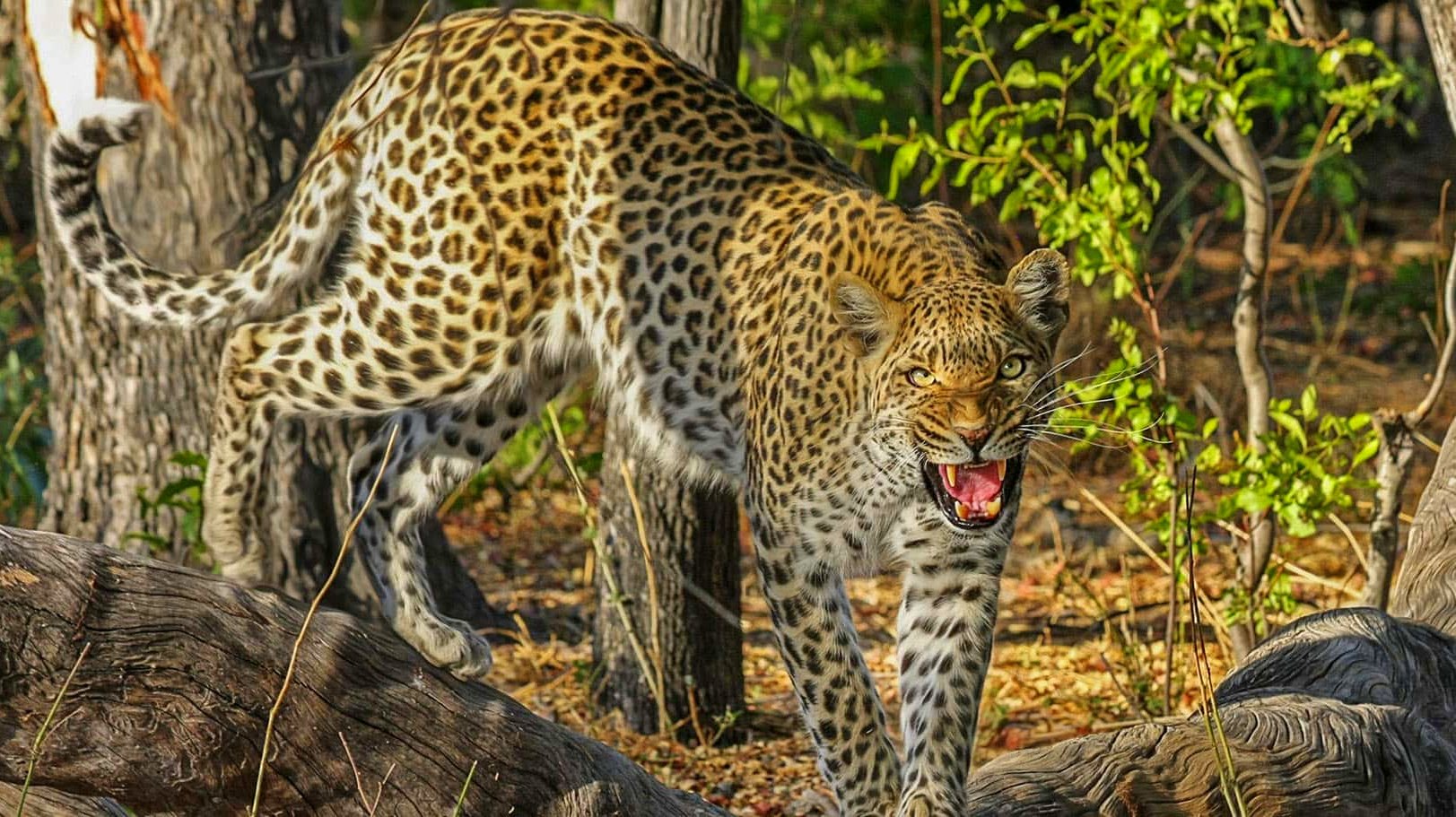
Luxury Safari Package Pricing
We offer comprehensive luxury safari packages starting from $150 to $400 per person per day, depending on your chosen destination and accommodation level. Our premium Chitwan National Park packages range from $200-300 daily, including luxury lodge stays, all meals, guided activities, and transportation. For the more exclusive Bardia National Park experience, our rates typically fall between $250-400 per day, offering unparalleled wilderness access and personalized service.
Our all-inclusive packages cover accommodation in 5-star jungle lodges, expert naturalist guides, jeep safaris, canoe rides, nature walks, cultural programs, and gourmet meals featuring local and international cuisine. We also include airport transfers, park permits, and professional photography assistance to capture your wildlife encounters.
For extended stays, we provide attractive discounts: 10% off for 4-6 nights, 15% off for week-long adventures, and customized pricing for group bookings of 6 or more participants. Our luxury family packages accommodate children with special rates and tailored activities suitable for different age groups.
Additional Activity Costs
Beyond our standard packages, we offer premium add-on experiences to enhance your safari adventure. Hot air balloon rides over the jungle canopy cost $200-250 per person, providing breathtaking aerial views of wildlife and landscapes. Professional wildlife photography workshops with renowned photographers range from $100-150 per session.
Cultural immersion experiences, including visits to indigenous Tharu villages and traditional dance performances, are available for $30-50 per person. We also arrange specialized bird watching tours with expert ornithologists at $75 per half-day session.
Adventure enthusiasts can enjoy elephant bathing experiences ($40-60), jungle camping under the stars ($80-120 per night), and guided fishing expeditions in pristine rivers ($90-130 per day). Our spa services at luxury lodges offer traditional Ayurvedic treatments starting from $60, perfect for relaxation after active safari days.
Private vehicle upgrades for exclusive game drives cost an additional $100-150 per day, ensuring personalized wildlife viewing without other guests. Helicopter transfers to remote locations range from $300-500, depending on distance and duration.
Tips for Getting the Best Value
We recommend booking your safari during the shoulder seasons (March-April and October-November) when our rates are most competitive while wildlife viewing remains excellent. Early bird bookings made 4-6 months in advance receive 15% discounts on our luxury packages.
Combining multiple national parks in one itinerary offers better value than separate trips. Our multi-park packages include Chitwan and Bardia at reduced per-day rates, plus we handle all logistics seamlessly. Group travel significantly reduces costs - families and friends booking together save 20-25% on individual pricing.
We suggest staying longer rather than upgrading accommodation levels if budget is a concern. Our 5-6 night packages provide deeper wildlife experiences and better photographic opportunities compared to rushed 2-3 day trips. Extended stays also allow for rest days and more diverse activities.
Flexible travel dates help us offer the best rates available. We maintain a waiting list for last-minute deals when luxury lodges have availability, sometimes offering 30-40% savings. Direct bookings through our company eliminate middleman fees, ensuring you receive our best published rates plus exclusive perks like room upgrades and welcome amenities.
Consider our all-inclusive packages instead of paying separately for activities, as bundled pricing typically saves 25-30% compared to individual bookings.
Nepal's incredible national parks and wildlife reserves offer us some of the most spectacular jungle safari experiences on the planet. We can encounter everything from the majestic Bengal tiger and one-horned rhinoceros to exotic bird species and playful elephants across destinations like Chitwan, Bardia, and other pristine wilderness areas. The variety of safari activities available - from traditional jeep safaris to guided nature walks and bird watching tours - ensures we can tailor our adventure to match our interests and comfort levels.
Planning our jungle safari becomes effortless when we consider the best visiting seasons, choose from luxury accommodation options that blend comfort with authentic wilderness experiences, and pack appropriately for the tropical climate. Whether we're working with a modest budget or seeking premium safari packages, Nepal's diverse itinerary options let us create unforgettable memories while supporting local conservation efforts. Start planning your Nepalese jungle adventure today and discover why this hidden gem continues to captivate wildlife enthusiasts from around the world.
If you need any further information, please contact us by email: [email protected], Phone: +977- 985 100 5129 (WhatsApp)
#Tags
Tripadvisor
5.0910 reviewsGoogle
4.8110 reviewsFacebook
4.1 recommend44 ReviewsTrustpilot
4.1 Great(5 reviews)- Trusted by50K plus traveller




